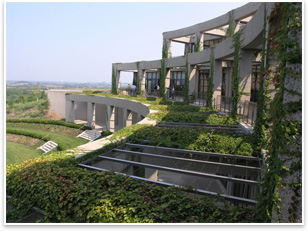Green Roof Biodiversity: Restoring High Rise Habitats
Bio-diverse green roofs reinforce sustainability benefits
by Layla Bellows
 Summary: Enter almost any high rise in a metro area and one of the first phrases residents or real estate agents will say is: “Look at this view.” But after you take a breathtaking glance at the expansive blue sky and smile at the twinkling lights of buildings far away, the only other thing left to look at are roofs. Acre after acre of them covered in asphalt and so hot in the summertime that even the heartiest of flora would wilt in minutes. It can be different and, increasingly, is. Summary: Enter almost any high rise in a metro area and one of the first phrases residents or real estate agents will say is: “Look at this view.” But after you take a breathtaking glance at the expansive blue sky and smile at the twinkling lights of buildings far away, the only other thing left to look at are roofs. Acre after acre of them covered in asphalt and so hot in the summertime that even the heartiest of flora would wilt in minutes. It can be different and, increasingly, is.
The Library of Congress’s National Audio Video Conservation Center. Photo by Matt Raymond.
View Slideshow
The deleterious effects of the standard roof are well known, as are the potent mitigating effects offered by green roofs. Although their high ROI might be green roofs’ most popular draw, they offer many benefits extending well beyond the bottom line, among them the positive effect they can have on the surrounding ecology.
A restorative approach
There’s quite a few biodiversity studies demonstrating that green roof habitats support a wide assortment of plants, insects, and birds—only all the evidence comes from Europe. One reason why the richest data come from across the pond is that green roofs have been a component of the urban landscapes in Germany and Switzerland for the better part of the past century. There’s a 90-year-old green roof in Zurich, Switzerland, for instance, that plays home to native orchids, and many Swiss cities have incorporated green roofs into an overall biodiversity strategy.
Stateside, green roofs certainly could have the potential to offer the same boon to a city’s biodiversity. However, in most cases, it’s still a little early to tell from an empirical standpoint.
“Anecdotally, we certainly see a wealth of life on city hall and on some of our other green roof projects,” says David Yocca, a principal landscape architect and planner at Chicago’s Conservation Design Forum. Chicago’s city hall (designed by well-known green firm William McDonough and Partners and completed in 2001) is among the earliest contemporary green roofs in the U.S. Although insects, birds, and bats have become common creatures on the roof, there hasn’t been a formal biodiversity study. Dave Hampton of Chicago’s Hampton Avery Architects [http://www.hampton-avery.com/] says he was also unable to generate interest in executing a biodiversity study of Chicago green roofs in general and the garden he helped create atop the True Nature Foods co-op in particular.
“Data are just lacking, especially in North America,” he says.
The current darling of America’s green roofs is San Francisco’s Academy of Sciences, designed by AIA Gold Medalist Renzo Piano, which has the built-in benefit of on-site staff able to monitor the living components of the roof. Although it’s too early to determine its long-term effects on San Francisco’s biodiversity, the roof planting itself is already biodiverse. This is because the San Francisco design firm Rana Creek led this component of the project, and its focus is on tending to the ecosystem first.
The company takes a restorative approach toward developing what they call living roofs in that they first analyze the ecosystems and plant life that are historically in an area and then try to recreate these habitats first and foremost. Sustainability features such as stormwater management become the result of the planting rather than the cause.
“If [the living roof] is really designed with the richness that comes with a biodiverse landscape, it’s going to naturally have stormwater benefits and clean the air and mitigate the urban heat island,” says Gabrielle Fladd, a senior landscape architect at Rana Creek. “It’s designing the way nature functions.”
 The American challenge The American challenge
The flip side, of course, is that a traditional roof is not a natural growing surface. In fact, Hampton jokes that when asked if True Nature Foods’ rooftop vegetable garden would focus on native plants, his colleague would respond with: “What plants are native to roofs?”
Both he and Yocca point to the thin soil profile necessary for most retrofitted roofs as a major challenge in what kind of plant life can be sustained. Ed Snodgrass, a farmer who worked with the design firm SWA Group on the Library of Congress National Audio Video Conservation Center in Virginia, points out that nearly all green roofs will have less than a foot of growing medium. But even these growing conditions can produce some fantastic results: The conservation center is housed in what was previously a large cold war bunker. After planting the roof, the nearly five-acre building, designed by San Francisco-based BAR Architects, almost disappeared into the surrounding habitat.
Although the acreage isn’t in an urban area, the effects of the living roof are the same. What was once a barren expanse of asphalt is now alive with growing things and the creatures that follow them. It doesn’t take a wealth of empirical evidence to know that this is more biologically diverse than what had been there.
A lack of empirical evidence makes it hard to pinpoint what the ultimate effects of green roofs in America might be. “I just think it’s a whole area that needs to be looked at more,” Yocca says. “We intuitively know it’s going to be better, but we don’t know how much or exactly how and why.” |



